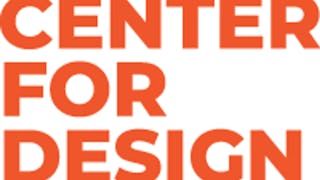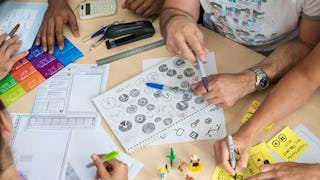In this course, you will learn how to design technologies that bring people joy, rather than frustration. You'll learn several techniques for rapidly prototyping (such as Wizard of Oz Prototyping) and evaluating multiple interface alternatives -- and why rapid prototyping and comparative evaluation are essential to excellent interaction design. You'll learn how to conduct fieldwork with people to help you get design ideas. How to make paper prototypes and low-fidelity mock-ups that are interactive -- and how to use these designs to get feedback from other stakeholders like your teammates, clients, and users. Armed with these design-thinking strategies, you’ll be able to do more creative human-centered design in any domain.



Human-Centered Design: an Introduction
This course is part of Interaction Design Specialization

Instructor: Scott Klemmer
142,345 already enrolled
Included with 
(2,753 reviews)
Details to know

Add to your LinkedIn profile
3 assignments
See how employees at top companies are mastering in-demand skills

Build your subject-matter expertise
- Learn new concepts from industry experts
- Gain a foundational understanding of a subject or tool
- Develop job-relevant skills with hands-on projects
- Earn a shareable career certificate


Earn a career certificate
Add this credential to your LinkedIn profile, resume, or CV
Share it on social media and in your performance review

There are 4 modules in this course
A brief introduction to the topics and goals of this Interaction Design Specialization
What's included
6 videos6 readings1 peer review
This module’s videos and assignment cover a really important topic: where can you get good design ideas from? Ideas that help you create meaningful designs that have a real impact on real people’s lives. Of course, good ideas come from lots of places. And wherever they come from, great. There are a few strategies I’ve found that are especially valuable, and that’s what we cover in this module’s videos. Given our focus on *real* people, we focus on going out, watching what people do, and talking to them. Check out the first video, describing participant observation. Combining observation with interviewing (the second video) provides a powerful foundation for needfinding and brainstorming.So what happens after you’ve observed a lot of stuff -- how do you connect the high-level needs to concrete design ideas? To help you bridge this gap, this module closes with a video on Creating Design Goals.
What's included
4 videos2 readings1 assignment1 peer review1 discussion prompt
This module's lectures introduce storyboarding and several strategies and media for rapid prototyping, including paper, Wizard of Oz Prototyping, and video. An important part of the creativity of a designer is to think about how you can rapidly prototype and get feedback on your ideas. Because it's almost never the case that the first idea you have will be the best. As a designer, you can learn the most when you're creating and getting feedback on multiple alternatives. Your work will nearly always benefit from thinking broadly to find the right design, and then from lots of polish to get the design right. Prototyping is also a great way to achieve common ground across the design team and other stakeholders. We begin with storyboards, paper prototyping and mockups. Students often ask about the relationship between needfinding and prototyping: how closely does one flow into the other? Ultimately the quality of your final design is the real measure and there are lots of ways to get there. While most design work benefits from prototypes directly informed by the needfinding process, it's not required. This module seeks to introduce you to doing human-centered design, and walk you through one path that such an approach could take. In both this Specialization and in real life, you are welcome to revise your ideas as much as you like.
What's included
4 videos2 readings1 assignment1 peer review
With this module's videos, we turn our focus from brainstorming and prototyping to the concrete elements of interaction design. We introduce ten key principles of good design -- like the importance of feedback and helping people recover from errors. We call these heuristics -- watch the first video here. I hope you'll find these heuristics practical and applicable to your work both inside and outside class. The lectures discuss these heuristics with a bunch of examples drawn from real-world designs. The goal is to illustrate the many ways that designs can be successful or run into trouble. While heuristic evaluations (HEs) focus on issues that lead to improvement they can also identify areas we think show successful compliance with a heuristic
What's included
5 videos2 readings1 assignment1 peer review
Instructor

Offered by
Recommended if you're interested in Design and Product


University of Illinois Urbana-Champaign


University of California San Diego


University of Minnesota


University of Michigan
Why people choose Coursera for their career




Learner reviews
2,753 reviews
- 5 stars
75.92%
- 4 stars
18.58%
- 3 stars
3.30%
- 2 stars
0.83%
- 1 star
1.34%
Showing 3 of 2753
Reviewed on Oct 3, 2016
In a short time I learned a whole lot about Interaction Design. I already feel confident enough to start working as a UI/UX designer. Thank you Prof. Scott Klemmer for his amazing insights.
Reviewed on Oct 3, 2019
Design is language to discuss with the end user for need finding and helping designing solution or system with user need or satisfaction, like sparking the joy of get things done.
Reviewed on Jun 5, 2016
I learned so much in this course!. The professor is really good and explains the concepts with practical examples. I really enjoyed this course and I am motivated to keep moving forward.
New to Design and Product? Start here.

Open new doors with Coursera Plus
Unlimited access to 10,000+ world-class courses, hands-on projects, and job-ready certificate programs - all included in your subscription
Advance your career with an online degree
Earn a degree from world-class universities - 100% online
Join over 3,400 global companies that choose Coursera for Business
Upskill your employees to excel in the digital economy
Frequently asked questions
Access to lectures and assignments depends on your type of enrollment. If you take a course in audit mode, you will be able to see most course materials for free. To access graded assignments and to earn a Certificate, you will need to purchase the Certificate experience, during or after your audit. If you don't see the audit option:
The course may not offer an audit option. You can try a Free Trial instead, or apply for Financial Aid.
The course may offer 'Full Course, No Certificate' instead. This option lets you see all course materials, submit required assessments, and get a final grade. This also means that you will not be able to purchase a Certificate experience.
When you enroll in the course, you get access to all of the courses in the Specialization, and you earn a certificate when you complete the work. Your electronic Certificate will be added to your Accomplishments page - from there, you can print your Certificate or add it to your LinkedIn profile. If you only want to read and view the course content, you can audit the course for free.
If you subscribed, you get a 7-day free trial during which you can cancel at no penalty. After that, we don’t give refunds, but you can cancel your subscription at any time. See our full refund policy.
More questions
Financial aid available,

